
Matricaria discoidea, commonly known as pineappleweed, wild chamomile, and disc mayweed, is an annual plant native to northeast Asia where it grows as a common herb of fields, gardens, and roadsides. It is in the family Asteraceae. The flowers exude a chamomile/pineapple aroma when crushed. They are edible and have been used in salads and to make herbal tea. Pineappleweed has been used for medicinal purposes, including for relief of gastrointestinal upset, infected sores, fevers, and postpartum anemia.

Pogogyne abramsii is a rare species of flowering plant in the mint family known by the common name San Diego mesa mint.

Pogogyne is a small genus of flowering plants in the mint family known generally as mesamints or mesa mints. They are native to Oregon, Idaho, California, and Baja California.
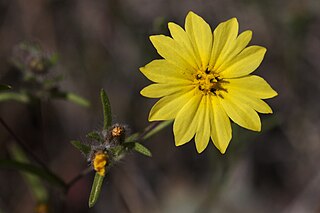
Lagophylla minor is a species of flowering plant in the sunflower family known by the common name lesser hareleaf. It is endemic to California, where it grows in the foothills surrounding the Sacramento Valley. It is a member of the plant communities growing on serpentine soils. This is an annual herb producing a thin, forking, purplish brown stem covered in small stiff hairs. The hairy leaves are 2 to 5 centimeters long and linear in shape, those on the lower stem toothed and those on the upper smooth-edged. The inflorescence bears flower heads with five bright yellow three-lobed ray florets, six yellow disc florets with black anthers, and phyllaries with long, soft hairs. The fruit is a glossy black achene two to three millimeters long.

Arctostaphylos obispoensis is a species of manzanita, known by the common names bishop manzanita and serpentine manzanita, endemic to California.
Arctostaphylos pilosula is a species of manzanita, known by the common names La Panza manzanita and Santa Margarita manzanita, that is endemic to California.
Astragalus pauperculus is an uncommon species of milkvetch known by the common name depauperate milkvetch. It is endemic to northern California, where it is known from the northern Sacramento Valley and the lowest reaches of the Cascade foothills adjacent. It grows in chaparral and vernally wet grassland habitat. This is a very small annual milkvetch which grows in a delicate mat with stems no longer than 10 cm (3.9 in). The leaves are a few centimeters long and are made up of small widely spaced leaflets. The inflorescence bears two to seven flowers which are purple, sometimes with paler colored edges on their petals. Each flower is generally less than 1 cm (0.39 in) long. The fruit is a crescent-shaped legume pod between 1 and 2 cm long.

Ceanothus roderickii is a rare species of shrub in the family Rhamnaceae known by the common name Pine Hill ceanothus. It is endemic to western El Dorado County, California, where it grows in the chaparral and woodlands of the Sierra Nevada foothills, such as the Pine Hill Ecological Reserve. It is named after 20th century California flora explorer, botanist, and arboretum director Wayne Roderick.

Chloropyron molle is a species of flowering plant in the family Orobanchaceae.
Eryngium pinnatisectum is an uncommon species of flowering plant in the family Apiaceae, known by the common names Tuolumne eryngo and Tuolumne button celery.

Lomatium caruifolium, known by the common name alkali desertparsley, is a species of flowering plant in the carrot family.
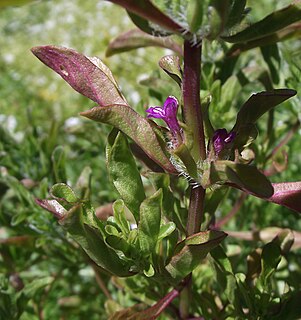
Pogogyne douglasii is a species of flowering plant in the mint family known by the common names Douglas' mesamint and Douglas' beardstyle.
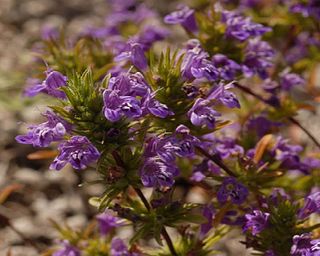
Pogogyne nudiuscula is a rare species of flowering plant in the mint family known by the common name Otay mesa mint. It is native to southern San Diego County, California, where it is known only from Otay Mesa near the border with Baja California. It was identified on land south of the Mexican border, but these occurrences have probably been extirpated. It is now known from seven vernal pool complexes just north of the border, and it is a federally listed endangered species of the United States.

Pogogyne serpylloides is a species of flowering plant in the mint family known by the common names thymeleaf mesamint and thymeleaf beardstyle. It is endemic to central California, where it grows in grassy habitat in coastal and inland mountain ranges and foothills. It is a petite aromatic annual herb growing decumbent or upright, often reaching no more than a centimeter in height even when erect in form, sometimes larger. The slender stem is sometimes branched. The inflorescence is a series of rounded, headlike clusters, with occasional single flowers emerging at leaf axils. The tiny tubular flower is 2 to 5 millimeters long and has a lobed, lipped mouth. It is lavender in color, sometimes with faint white markings in the mouth.

Psilocarphus brevissimus is a species of flowering plant in the aster family known by the common names short woollyheads, woolly marbles, and woolly heads.
Ranunculus canus is a species of buttercup known by the common name Sacramento Valley buttercup. It is endemic to California, where it grows in the Central Valley and adjacent mountain foothills, and the Transverse Ranges just south. It grows in grassland and meadows in woodland and forest habitat. This plant can be very similar in appearance to the California buttercup, and may be difficult to distinguish from it. It is variable in form. In general the plant is a perennial herb producing erect, usually hairy stems up to 65 centimeters tall. The hairy leaves are each made up of three leaflets, leaves occurring lower on the plant with wider leaflets which may be notched to lobed, and upper leaves with narrow, toothed leaflets. The flower has up to 23 shiny yellow petals and many yellow stamens and pistils at the center. The fruit is an achene, borne in a spherical cluster of 11 or more.
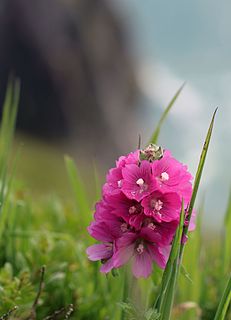
Sidalcea hirsuta is a species of flowering plant in the mallow family known by the common name hairy checkerbloom.
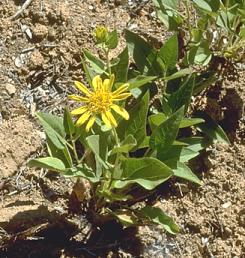
Agnorhiza reticulata, known by the common name El Dorado County mule's ears, is a rare species of flowering plant found only in a small region of north-central California.

Limnobium laevigatum is a floating aquatic plant, and is a member of the family Hydrocharitaceae. Common names include West Indian spongeplant, South American spongeplant and Amazon or smooth frogbit. This plant was introduced to North American waterways through use in aquariums and aquascapes.

The Phoenix Vernal Pools are located in Fair Oaks, a suburb of Sacramento city, around 20 miles east of the city of Sacramento and north of highway 50. This land consists of seasonally inundated wetlands that form after winter rains. The climate type of Phoenix Vernal Pools is classified as Mediterranean, receiving 24 in (610 mm) of rain per year. The rainwater percolates into the soil until it reaches an impermeable hardpan that causes an elevated water table, forming the vernal pools. The Phoenix Vernal Pool ecosystem is relatively unique as is supports many species of fauna and flora endemic to vernal pools.














